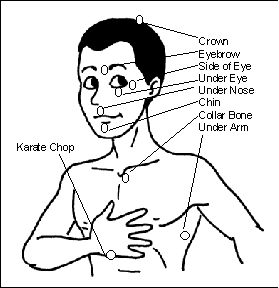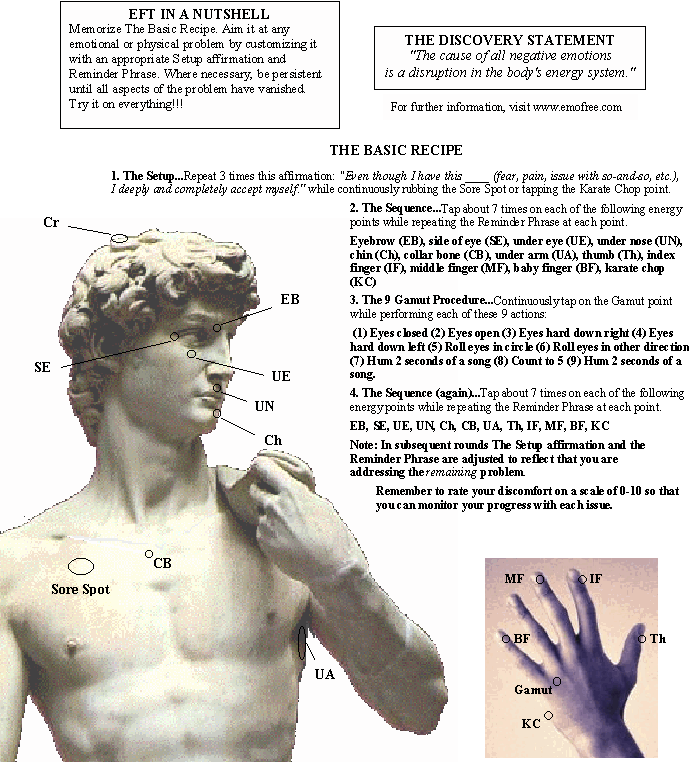Until you make the unconscious conscious,
it will direct your life and you will call it fate.
– Carl Jung
All healing is essentially the release from fear.
– A Course In Miracles
Emotional Freedom Technique (EFT) does exactly what it says: it is a simple, easy way to release fear. It is a deceptively simple, yet effective tool for healing the mind, emotions and even the body.
To keep it simple, let’s call everything that is not at ease and peaceful, “fear”. Pain and dis-ease indicate a lack of ease, a lack of peace, and we can often track disease to its origin in fear.
We react to fear by contracting muscles in our body; we fight, flee or freeze. Synonyms for “fear” might include shock, terror, horror, dread, panic, anxiety, anger, rage, fury, sorrow, grief, angst, overwhelm, boredom, loss, frustration, irritability, loneliness, broken heart, longing, desire, jealousy, regret, envy, revenge, or any other feeling that is not peaceful and loving. Fear enters the mind, the body reacts by contracting. After that, if the fear is not released, it remains lodged in the muscles and even the cells of the body.
“Fear” is not our original condition – love is. Look into the eyes of any baby who was gently born and not circumcised and you will see eyes overflowing with unconditional love, aliveness, enthusiasm, and joy. Babies who have not been terrorized by intrusive medical procedures, drugs and scalpels, are relaxed. They can fall to sleep in a moment, no matter where they are or what is going on.
Yet a baby who was poked by sonogram, whose birth was medically induced, who was cut out or pulled out of his mothers, whose umbilical cord lifeline to mother was cut before he had downloaded his full allotment of oxygen and blood, who had monitoring devices attached to his head and body, a baby who was separated from his mother at birth and fed cow’s milk, not breastfed, a baby who was exposed to any number of unnecessary procedures such as blinding lights, heel pricks, injections of toxic chemicals into his pristine bloodstream, a baby who had surgery such as circumcision or open heart surgery… This baby, on the other hand, had a head start in the accumulation of fear. He learned to contract and withdraw, to distrust and expect betrayal.
After birth, fear messages are sent directly and indirectly, intentionally and unintentionally, from family members, friends, school, religion, television, movies, society; we make decisions based on things that happen to us and to others, etc and we carry all this fear forever – on our shoulders, in our stomachs or chests – until and unless we let it all go. We carry unconscious fear in the subconscious and the subconscious is the body. Muscles we tensed up long ago when terrible things happened, still hold the tension. They are the spots where we feel pain, tension, weakness. The good news is, we can let it all go and EFT is a very helpful tool in releasing fear. Letting go of fear is letting go of tension in the body and most disorders, disease, are caused by stored fear, tension.
Emotional Freedom Technique is the most effective way I’ve found to quickly and easily loosen and release uncomfortable bodily sensations from the mind and body – both ancient and current.
EFT is also called “tapping”, and you will be tapping on acupressure points to relax the inner organs that have been holding the “fear” you want to be free of.
Steps for using EFT to release fear:
1) Identify a feeling or attitude that causes you discomfort, a “fear” you want to release. Put it into words. If you cannot find a descriptor for it, just identify it by its location in the body. Examples might be: sense of anxiety, pain in my stomach, tension in my shoulders, anger at my mother.
2) Give it an intensity score. Zero means it does not bother you at all, ten means it is very much present, in your current awareness, and is occupying your mind and giving you pain and discomfort at this very moment. The goal is to use EFT until the intensity is gone and the score moves to zero.
3) Make it into a statement:
Even though I have this
[pain in my stomach],
I deeply and completely love and respect myself.
This statement serves a few purposes:
- Naming the emotion or locating a feeling in the body is an important step in letting it go, for you are no longer unaware of it – you are now conscious of it. You have given the “demon” a name.
- You can only release something that you already “have”. If you are unaware of a feeling, then you do not “have” it; it “has” you. But once you have it, you can release it.
- “Even though” minimizes the importance of the “fear” you have named. It says that this “thing” that has been burdening you for a very long time is now inconsequential and you are ready to let it go.
- To say that you love and respect yourself, even though you have carried this feeling, is a way of saying that you forgive yourself and love yourself enough to live without the burden.
4) The simplest way to perform this “exorcism” on yourself is to repeat the statement in #3, above, and tap 8-10 times on each acupressure point (see diagrams below). Some start by tapping on the side of one hand (karote chop point, in diagram below), using the palm of the other hand, and repeating the statement a few times, adjusting it for accuracy, if necessary. Then, starting at the top of your head, tap each point several times while repeating the statement. Some people shorten the statement after a few repetitions to the ‘complaint’, such as:
Even though I have this [sense of guilt], I deeply and completely love and respect myself…
Even though I have this sorrow, I deeply and completely love and respect myself…
Even though I have this sorrow, I deeply and completely love and respect myself…
this sorrow… this sorrow… this sorrow…” – concluding with,
Even though I have this sorrow, I deeply and completely love and respect myself.
Now it is time to re-evaluate the intensity score you gave to the emotion in the beginning. On a scale from 1 to 10, how intense is the sensation now?
Some issues will resolve in one short round. Others may require several rounds, alternating tapping on both sides of the body. And some very old – or very fresh – issues may need to be addressed several times for several days. The good news is, it will all go away and stay away, once you have tapped it away. A little bit of attention now prevents years of discomfort in the future.
Here are two helpful diagrams you can download and print or access at any time from your phone or computer to remind you of how to use EFT:
 and
and




